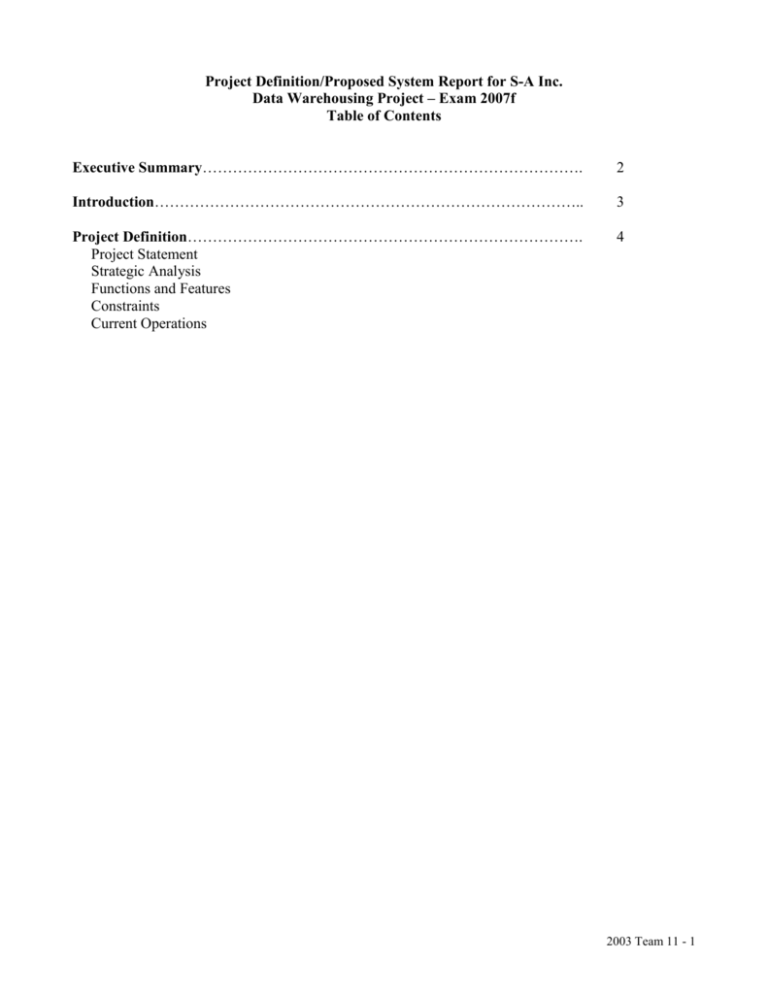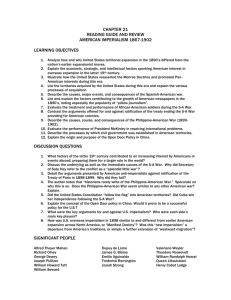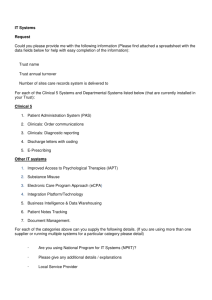Exam Case and Questions (questions at end)
advertisement

Project Definition/Proposed System Report for S-A Inc. Data Warehousing Project – Exam 2007f Table of Contents Executive Summary…………………………………………………………………. 2 Introduction………………………………………………………………………….. 3 Project Definition……………………………………………………………………. Project Statement Strategic Analysis Functions and Features Constraints Current Operations 4 2003 Team 11 - 1 Executive Summary Project Definition/Proposed System Report for S-A Inc. Data Warehousing Project – Team 11 S-Aasked Team 11 to prepare a new computer-based system for evaluating the effectiveness of its call center training classes because the current system is inefficient and does not address the call center’s strategic objectives: to increase the sales revenue generated per call and decrease the number of sales and service call errors. The new system will address these objectives by using revenue per call and ‘flub’ data to generate report cards for class categories (sales and service), specific classes, and trainers. The system will also use the same data to create a list of the employees who, judging by their performance numbers, need additional training. These two features will enable management to focus and trim the call center training program to provide effective training to those who need it most. This will lower training costs, increase sales directly through better employee sales skills and indirectly through improved customer experience and resulting word-of-mouth advertising, and reduce quality control costs by improving employee proficiency. Team 11 understands that the new system must work within S-A’s existing business processes and physical infrastructure, be delivered by the end of November 2003, and require no initial expenditure. Therefore, the team will consider two solution classes: a customized system built by the team, or an existing software package. The new system will collect relevant employee, revenue, error, and training information from three existing data sources (revenue statistics, error statistics, and training information) and create a data warehouse. The system will draw upon this warehouse to create the above-mentioned reports. 2003 Team 11 - 2 Project Definition/Proposed System Report for S-A Inc. Data Warehousing Project – Team 11 Introduction Project Definition. Project Statement: design a new computer system to evaluate the effectiveness of training classes and assist managers in targeting future training at those who need it most. Strategic Analysis: highlights the call center’s relevant strategic objectives: to increase revenue per sales call and reduce the number of sales and service call mistakes. Functions and Features: the new system will produce three categories of evaluative report: class category, specific class, and trainer. The system will also include a function that will generate a list of employees who need training the most. Constraints: lists budget, time, organizational, and infrastructure constraints. S-Awill consider two solution classes: a custom system built by Team 11, or an existing software package. Current Operations: the current system for evaluating training classes is rarely used because of inefficiency. It requires manual analysis of data from two databases and an evaluation form. 2003 Team 11 - 3 Current Situation Analysis Project Statement Design a new computer-based system for evaluating the effectiveness of call center training classes because the current system is inefficient and insufficient. The new system will be designed to affect a reduction in training costs, an increase in call center sales, and an increase in the quality and consistency of call center customer service. Strategic Analysis of the Oklahoma City Call Center Organization. The Oklahoma City call center handles both sales and service calls for S-A product lines. The call center generates approximately 33% of S-A direct-to-customer sales, which include catalogue-generated sales and internet sales, and provides customer support for these products, as well as those sold in retail stores and outlets. Mission. The call center focus is on providing a quality customer experience, both during and after a sale. Mr. Cloud, a Performance/Business Analyst for the center, states the William Sonoma mission as, “Excellence: Every Customer, Every Interaction, Every Day.” Major Strategies. Mr. Cloud and Mr. Holland identified the following strategic objectives: 1. 2. Increase the sales revenue per call for sales representatives Reduce the number of customer service and sales call errors A reduction in the number of customer service and sales call errors will be realized through the development of a better targeted and more effective training program. This will not only reduce quality control costs at the call center, but improve the customer experience, which will lead to increased customer loyalty and word-of-mouth advertising. This in turn will lead to steady growth in the S-A customer base and increased revenue per call. Measures of Performance. S-A measures performance with two major statistics. Errors, or “flubs,” give an indication of the quality of service that S-Aassociates are providing to customers. Revenue per call, or RPC, reflects sales performance. New System Contribution to Performance. The new system will contribute directly to both of the above-listed strategic objectives. By providing analysis of employee training and performance histories, the system will enable managers to target training classes at the employees who need them the most. In addition, the system will provide a way for managers to evaluate the effectiveness of specific classes and trainers and adjust future training schedules accordingly. Function and Features for the Proposed System The following functions and features were identified in discussions with the client and will contribute to the strategic objectives identified in the strategic analysis. 1. Training Evaluation Reports: each report will use aggregate revenue per call and ‘flub’ data to provide report card for the category, class, or trainer in question. The report card will contain details regarding employee performance in the periods before and after the class, which will 2003 Team 11 - 4 allow managers to determine whether or not the class is effective in accomplishing its objective. a. By Category. This report will generate two report cards: one for all Sales classes and one for all Service Classes. b. By Class. This report will generate a report card for a specific class. The report will encompass all sections and trainers for the class. c. By Trainer. This report is a trainer evaluation tool and will generate a report card for a specific trainer. The report will list aggregate performance numbers for the trainer as well as performance numbers by class. 2. A ‘Who Needs It’ button. This system function will use revenue per call and ‘flub’ figures to generate a list of the best and worst performing employees. The list can be used to determine who needs training the most, and in what area – sales or service. The client also asks that the new system be able to accept, from an external program, a single string variable containing information regarding the class name, class section, class category, class trainer, and class date. The client asked our team to recommend a way to format the string and wants the system to be able to parse it and store the data in relevant tables. Constraints for the Proposed System Budget: the client has been clear that there must be a clear business case for building the system. Organizational: S-Ais not willing to make any major changes in its organizational structure. Therefore, the system must work within the company’s existing business processes. Modification to the current spread-sheet based tables is possible. Physical Infrastructure: the client wants the new system to operate within their existing Microsoft based database management system. Description of Current Operations The S-A call center currently operates a manual system for evaluation of its training classes. The manual system is rarely used and only at the request of the managers, or similar personnel. If a manager wishes to evaluate an employee they must pull information from two Microsoft Access tables and one Microsoft Excel spreadsheet –Revenue Statistics, Error (flub) Statistics, and Training Class. The manager manually puts together error and revenue information from the Revenue Statistics and Error Statistics tables and training dates from the Training Class spreadsheet to compile a statistics report for a given time period. The Revenue Statistics table contains records for all employees. Each record contains weekly entries consisting of the dollar amount of revenue and number of calls for one employee. The Error Statistics table also contains records for all employees. Each one of these records includes the number good calls and bad calls for each employee and is updated daily. The Training Class spreadsheet contains dates of each training class an employee was scheduled for, as well as attendance figures for that employee. When a new employee is hired, his/her name is copied into the Revenue Statistics table, the Error Statistics table, and the Training Class spreadsheet by an authorized employee. As the employee completes training classes, training information – employee information, training class, training dates, 2003 Team 11 - 5 employee attendance figures – is entered into the training spreadsheet. Once the new employee starts taking calls from customers, a manager begins entering data for that employee into the two database tables. Call volume and revenue data is entered into the Revenue Statistics table weekly, and flub data is entered into the Error Statistics table daily. To generate a training class report, a manager must first open up the two data tables and calculate (by employee) revenue per call and aggregate flubs. Revenue per call is calculated by dividing the total sales dollars generated through sales calls by a given employee within a given time period by the number of sales calls taken by that employee within the same time period. Flub data is simply aggregated for that time period to arrive at a total number of errors for an employee. After completing the calculations, the manager must use employee training data from the training spreadsheet to create the report. The diagrams on the following page illustrate the current system. 2003 Team 11 - 6 DFD – Current System Revenue Statistics Table Error (flub) Statistics Table Manual Process to Compile Training Report Training Class Spreadsheet Managers ERD – Current System Error Statistics User_ID date hours_worked credits_processed credits_successed refunds_processed refunds_successed charges_processed charges_successed replacements/exchanges_ processed replacements/exchanges_ successed onlines_processed onlines_successed Revenue Statistics Kronos_ID Employee_Name date hours_worked minutes_on_line sales_calls order_total Training Class Info start date number_of_hours Employee_Name Memo 2003 Team 11 - 7 The tables above are separate report tables generated by different tracking systems in the organization. While the systems cannot be replaced, the tables can be modified somewhat. Error Statistics. These results are generated by the sales tracking system used by S-A associates. Actions processed are actions attempted by the associate; actions successed are actions processed without error. The User_ID is a system generated ID used by the employee tracking system. Revenue Statistics. The Kronos system is a commercial-off-the-shelf ordering system used by a number of different call centers. It generates its own Kronos_ID numbers for employees and summarizes various employee performance measures. The output from this system displays daily summaries of hours_worked, minutes_on_line (actually connected to a customer) and other performance measures. Training Class Info. This is a spread-sheet file completed for each training class taught and S-A is willing to modify the information it captures if necessary. The file itself has the employee name for attendees. The name of the file contains the course title. The company training coordinator also keeps track of the instructor and has a longer description of the course content. Some classes are longer than one day and employees may not attend every session. Thus an employee may attend day one sessions in December and day two in March. Physical and Organizational Infrastructure As described above, the William Sonoma call center operates a manual training system. Any manager or similar personnel that wish to obtain reports of performance must pull the revenue and error information from tables that are stored in a Microsoft Access 97 database from a specified work station. The training class information is on a Microsoft Excel spreadsheet and it must also be pulled. They must physically combine these parts of data in order to craft a report. The report then can be distributed to any parties that wish to see it. Problem Analysis The following problems have been identified in the current system: 1. Because it takes so long to compile the report using the current system, it is seldom used. This means that high employee error levels and low employee sales figures can go unnoticed for long periods of time. 2. The reports generated by the current system fail to effectively tie employee performance to specific training classes. The reports also fail to provide an efficient means of comparing performance between employees. 3. When the system is used, the opportunity cost to the manager that compiles the report is large. That is, lots of valuable time is wasted doing iterative calculations. 4. Because of the high number of manual calculations required to generate the report, there is, because people have a tendency to make mistakes while manually compiling data, for substantial inaccuracies in the report. Retention and Change Analysis The proposed system will have more features and functions than the current system, but will call on the same Revenue and Error data to support these features. In addition, the proposed system will retain the idea behind the existing report, but modify the presentation and content to provide a more useful analysis of training class categories, classes, and trainers. 2003 Team 11 - 8 Data Warehousing Final Exam Take Home Questions Fall 2007 1. Do you think that developing this as a data warehouse is a good idea? What are arguments for and against it? 2. Provide a dimensional model for the proposed system. a) What is the grain of the proposed mart? b) What are questions that the mart is designed to manage? Who are the potential users? c) Provide a diagram for the mart including facts and attributes. 3. Assuming you can add reasonable attributes, what are two hierarchies that you might include in the dimensional designs? 4. What are data cleansing steps you expect to have to conduct in order to develop a good representation of the associates? (Focus on a common representation of the people.) 5. The call center employs about 150 associates. What computer infrastructure issues do you anticipate needing to deal with? 6. Are there any organizational concerns that you need to address? (Consider the Training Class Info. What about maintenance?) 2003 Team 11 - 9






